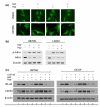HGF upregulates CXCR4 expression in gliomas via NF-kappaB: implications for glioma cell migration
- PMID: 20157762
- PMCID: PMC3767998
- DOI: 10.1007/s11060-010-0111-2
HGF upregulates CXCR4 expression in gliomas via NF-kappaB: implications for glioma cell migration
Abstract
Invasion is a hallmark of malignant gliomas and is the main reason for therapeutic failure and recurrence of the tumor. CXCR4 is a key chemokine receptor implicated in glioma cell migration whose expression is regulated by hypoxia. Here, we report that hepatocyte growth factor (HGF) upregulated CXCR4 protein expression in glioma cells. HGF pre-treatment increased migration of U87MG and LN229 glioma cells towards the CXCR4 ligand, stromal cell-derived factor-1alpha (SDF-1alpha). AMD3100, a CXCR4 inhibitor, inhibited the increased migration of HGF pre-treated LN229 glioma cells towards SDF-1alpha. Following exposure to HGF and hypoxia, both cell lines showed nuclear translocation of NF-kappaB (p65). The HGF- and hypoxia-induced nuclear translocation of NF-kappaB (p65) involved phosphorylation and degradation of IkappaB-alpha. Knock-down of NF-kappaB expression inhibited the induction of CXCR4 expression in response to HGF, but not to hypoxia. However, knock-down of NF-kappaB expression inhibited the induction of CXCR4 expression in response to hypoxia in the presence of HGF. NF-kappaB mediated migration towards SDF-1alpha in response to HGF. Knock-down of NF-kappaB expression resulted in decreased migration of HGF pre-treated glioma cells towards SDF-1alpha. Therefore, HGF upregulates CXCR4 expression via NF-kappaB and leads to enhanced migration. To our knowledge, this is the first report to show that a crosstalk mediated by NF-kappaB exists between the SDF-1alpha/CXCR4 and HGF/c-Met axes relevant to glioma cell migration. These findings imply that effective inhibition of glioma invasion should be directed against several ligand/receptor signaling pathways.
Figures





Similar articles
-
Stromal cell-derived factor-1/CXCR4 enhanced motility of human osteosarcoma cells involves MEK1/2, ERK and NF-kappaB-dependent pathways.J Cell Physiol. 2009 Oct;221(1):204-12. doi: 10.1002/jcp.21846. J Cell Physiol. 2009. PMID: 19496172
-
CXCR7 is induced by hypoxia and mediates glioma cell migration towards SDF-1α.BMC Cancer. 2013 Jul 17;13:347. doi: 10.1186/1471-2407-13-347. BMC Cancer. 2013. PMID: 23865743 Free PMC article.
-
Up-regulation of CXCR4 expression in PC-3 cells by stromal-derived factor-1alpha (CXCL12) increases endothelial adhesion and transendothelial migration: role of MEK/ERK signaling pathway-dependent NF-kappaB activation.Cancer Res. 2005 Nov 1;65(21):9891-8. doi: 10.1158/0008-5472.CAN-05-1293. Cancer Res. 2005. PMID: 16267013
-
The role of the CXCR4 cell surface chemokine receptor in glioma biology.J Neurooncol. 2013 Jun;113(2):153-62. doi: 10.1007/s11060-013-1108-4. Epub 2013 Mar 14. J Neurooncol. 2013. PMID: 23494875 Review.
-
Anti-cancer therapeutic strategies based on HGF/MET, EpCAM, and tumor-stromal cross talk.Cancer Cell Int. 2022 Aug 19;22(1):259. doi: 10.1186/s12935-022-02658-z. Cancer Cell Int. 2022. PMID: 35986321 Free PMC article. Review.
Cited by
-
MET in glioma: signaling pathways and targeted therapies.J Exp Clin Cancer Res. 2019 Jun 20;38(1):270. doi: 10.1186/s13046-019-1269-x. J Exp Clin Cancer Res. 2019. PMID: 31221203 Free PMC article. Review.
-
AXL and MET crosstalk to promote gonadotropin releasing hormone (GnRH) neuronal cell migration and survival.Mol Cell Endocrinol. 2013 Jul 15;374(1-2):92-100. doi: 10.1016/j.mce.2013.04.018. Epub 2013 May 3. Mol Cell Endocrinol. 2013. PMID: 23648337 Free PMC article.
-
A functional polymorphism in the pre-miR-146a gene is associated with risk and prognosis in adult glioma.J Neurooncol. 2011 Dec;105(3):639-46. doi: 10.1007/s11060-011-0634-1. Epub 2011 Jul 9. J Neurooncol. 2011. PMID: 21744077 Free PMC article.
-
Astrocytes enhance the invasion potential of glioblastoma stem-like cells.PLoS One. 2013;8(1):e54752. doi: 10.1371/journal.pone.0054752. Epub 2013 Jan 22. PLoS One. 2013. PMID: 23349962 Free PMC article.
-
Nix protein positively regulates NF-κB activation in gliomas.PLoS One. 2012;7(9):e44559. doi: 10.1371/journal.pone.0044559. Epub 2012 Sep 12. PLoS One. 2012. PMID: 22984526 Free PMC article.
References
-
- Mueller MM, Werbowetski T, Del Maestro RF. Soluble factors involved in glioma invasion. Acta Neurochir (Wien) 2003;145:999–1008. - PubMed
-
- Giese A, Bjerkvig R, Berens ME, et al. Cost of migration: invasion of malignant gliomas and implications for treatment. J Clin Oncol. 2003;21:1624–1636. - PubMed
-
- Rempel SA, Dudas S, Ge S, et al. Identification and localization of the cytokine SDF1 and its receptor, CXC chemokine receptor 4, to regions of necrosis and angiogenesis in human glioblastoma. Clin Cancer Res. 2000;6:102–111. - PubMed
-
- Muller A, Homey B, Soto H, et al. Involvement of chemokine receptors in breast cancer metastasis. Nature. 2001;410:50–56. - PubMed
Publication types
MeSH terms
Substances
Grants and funding
LinkOut - more resources
Full Text Sources
Miscellaneous

